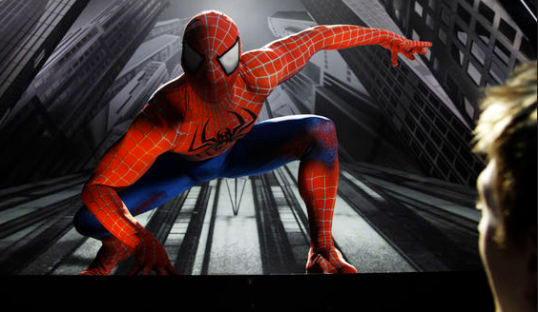Comic-book scholars and creators often refer to superhero stories as modern-day myths. Like the fables of ancient civilizations, the adventures of larger-than-life figures like Superman, the Hulk or Swamp Thing can be used as lens to help us understand the world and ourselves. Superhero characters can be rich metaphors, whether it’s for an immigrant achieving great feats in a new land, the dangerous yet energizing power of the id, or the importance of harmony with the Earth.
Spider-Man’s core ethos gets famously summed up in the immortal caption “With great power… must come great responsibility!” As a modern-day myth, the web-slinger hasn’t done too bad for himself. He’s been successfully adapted to cartoons, live-action TV (ok, maybe those weren’t so successful) and blockbuster movies. And now, Aunt May’s favorite nephew commutes from Queens to Manhattan for a new Broadway musical called Spider-Man: Turn Off the Dark. Any comics nerd in front of a computer screen over the last couple of months knows the bullet points: Music by U2’s Bono and the Edge. Directed by Tony-winning visionary Julie Taymor. Most expensive Broadway show ever at $65 million. Production delays and cast injuries. And photos in Vogue that raised the eyebrows of most anyone who saw them.
(More on TIME.com: The Amazing, Spectacular Story Behind The Spider-Man Musical)
So, how do the people putting on the show live up to the responsibility of bringing Spidey to the stage? Turn Off the Dark will charm the curious in thrilling ways but does have stylistic problems that render its understanding of Marvel’s mascot seriously muddled. The show starts promisingly with a backdrop of giant Steve Ditko art welcoming the audience and Taymor seems to understand Spidey’s power as a symbol, plugging him directly into another mythology. Part of the show’s first act gets narrated by a Geek Chorus, a group of teenagers making up Spider-Man stories of their own. They’re the device through which the show connects to Greco-Roman folklore, specifically Arachne. The weaver–who challenged Athena only to get changed into a spider as the cost of her hubris–gets positioned as a mystical spider-force. So that spider-bite that fateful day in the science lab (run by Norman Osborn, as in the Ultimate Spider-Man comics) isn’t all accident, as the show suggests that Arachne chose to gift Peter with the powers of her familiar.
(More on TIME.com: So, Yeah, About That New Spider-Man Musical…)
From there, liberties get taken with the characterization of familiar Spidey personas but they don’t all pay off. One of the show’s biggest missteps happens with the tragic part of Spider-Man’s origin. Uncle Ben’s death happens quickly and awkwardly, with him running to stop the getaway car of the thief Peter fails to stop after earning Because the musical shifts the origin to a mythological bent, it feels like they’re giving short shrift to one of the best superhero origins ever. Peter needs to be partially responsible for Ben’s death to earn his own maturity and making it more happenstance than anything else drains the drama away. I’m all for reconfiguring or recontextualizing a character’s mythos when they make the jump to a new medium but this tweak only dilutes the connection between Uncle Ben’s death and Spider-man’s raison d’etre.
(More on Time.com: Does Whatever Four Spideys Can: Shattered Dimensions Review)
Reeve Carney’s Peter/Spidey gets the nebbishy/wisecracking bits down pat and Jennifer Damiano turns in a surprisingly soulful performance as Mary Jane Watson. The two perform well together, too. The musical numbers are a mixed bag. While the muscular acrobatics of the show’s choreography consistently impresses and the cast all boast great singing voices, some of the songs feel like too U2. There’s an aesthetic clash that sounds as if Bono’s keening delivery and the Edge’s fractured guitar riffs were shoehorned into a Power Records superhero LP. “Bouncing Off the Walls”–the hey-I’ve-got-superpowers sequence–is by far the best number, followed by “Rise Above.” Meanwhile, other tunes like “Pull the Trigger” and “Deeply Furious” come off as too busy or scattered to be memorable.
Veteran actor Patrick Page plays Norman Osborn/the Green Goblin as a blustery super-scientist with a Southern accent, adding nothing to the character and unfortunately making his villainy seem way too campy. Worse still, the Goblin’s origin gets a semi-sympathetic spin, portraying him as a happily married man caught up in the unforgiving vice grip of the military-industrial complex. This Green Goblin’s the result of genetic experimentation, which apparently included some DNA from Jack Napier. Page’s Goblin steals a few scenes–including a hilarious “I’ll Take Manhattan”–but those used to seeing Osborn as a single-mindedly maniacal archfoe won’t be happy with the interpretation here. The character basically disappears from the second act and, while that’s merciful, it severs the flow of the show.


